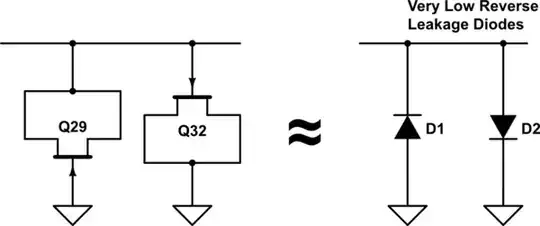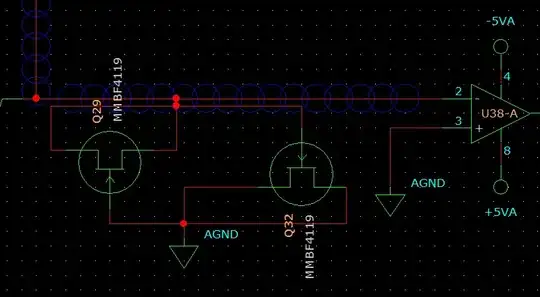I have come across this circuit with two JFETs as shown below. Does anyone know what is the purpose of these two JFETs?
-
7Looks like low-leakage clamp diodes to protect the opamp from over-voltage. Hard to tell for sure from this schematic fragment. – glen_geek Jul 25 '23 at 14:01
-
1The 4119 is renowned for its low gate leakage – tobalt Jul 25 '23 at 14:29
-
Is this drawn right? With the drains and sources shorted together I have a hard time seeing how this does anything useful. Maybe with the drain shorted to the gate...Can somebody enlighten me? – evildemonic Jul 25 '23 at 15:58
-
Thank you for the answer – user42423 Jul 26 '23 at 01:46
-
2@evildemonic The JFETs are being used as diodes (remember that the gate is a diode junction); the MMBF4119 has incredibly low reverse leakage, of 10 pA maximum at room temperature according to this Fairchild/onsemi datasheet, much lower than any actual diode I've ever seen. – Hearth Jul 26 '23 at 04:25
1 Answers
Each of the JFETs is diode-connected:

simulate this circuit – Schematic created using CircuitLab
The protected line is clamped to within about ±0.5V from ground for sources driving well under 1mA, and up to ±1V away from ground for sources driving energetic spikes.
An alternative would be to use a diode-connected BJT - some of those have very low leakage as well. In all cases you'd want to qualify the parts for such use, i.e. grab a bunch and test them in the temperature range you care about. Then keep repeating the tests with each lot of parts - if the parts don't have the leakage spec in the datasheet. In most cases it's way cheaper to buy a couple reels of parts from the same lot to cover several years of demand than testing over and over. On the other hand, not having to repeat in-house testing almost guarantees that the necessary institutional knowledge will evaporate, unless that's a well-functioning documentation process in place.
- 40,960
- 1
- 39
- 120
-
-
2Note that a diode-connected BJT would work in this application, but only because there are two antiparallel ones (so the reverse voltage is never more than a diode drop). You couldn't use a single BJT to replace one of these on its own, because it's very unlikely you could find a BJT rated to withstand 40 V reverse on the base-emitter junction. – Hearth Jul 26 '23 at 04:57
-
@Hearth Yes. And there's a further catch: suppose you add a basic silicon diode or a Schottky in series. The discrete diode will have higher reverse leakage than the BJT, and that current has to come from somewhere. It will unfortunately come when the B-E junction breaks down in reverse. Sometimes you can get an oscillator that way. – Kuba hasn't forgotten Monica Sep 09 '23 at 16:01
